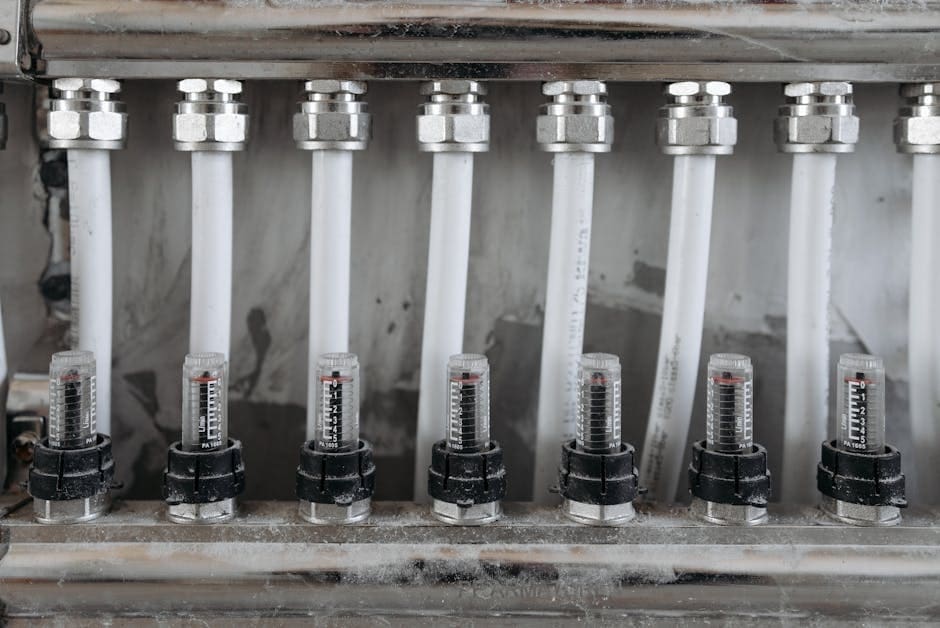Flow divider valves are an essential part of advanced hydraulic systems. They efficiently split or unify flows, ensuring balanced output across various applications. These devices are critical for controlling hydraulic systems’ performance and efficiency in industries like manufacturing, construction, and agriculture. At their core, flow divider valves help maintain desired flow rates, stabilize system pressure, and improve overall productivity.
For a quick snapshot on flow divider valves:
- Function: Control and divide hydraulic flow to achieve balanced pressure and flow rates.
- Application: Used in complex industrial systems for precision flow management.
- Benefit: Improves efficiency by maintaining steady flow and pressure, reducing wear and tear on machinery.
I’m Todd Cleppe, CEO & Co-Founder at CFAB Global, with over 25 years of experience in enhancing machinery performance. Throughout my career, I’ve used flow divider valves to improve hydraulic system reliability and efficiency, offering custom solutions that increase operational uptime and reduce costs.

Flow divider valves terms at a glance:
– adjustable hydraulic flow divider
– how does a hydraulic flow divider valve work
– hydraulic priority flow divider
Understanding Flow Divider Valves
Flow divider valves are crucial components in hydraulic systems, playing a vital role in managing oil flow. These valves ensure that hydraulic fluid is distributed evenly across different parts of the system, which is essential for maintaining balanced operation and preventing system overloads.
Types of Flow Divider Valves
Flow divider valves come in two main types: motor type and orifice type.
-
Motor Type: These use hydraulic motors to split the flow. They are ideal for applications needing precise flow division, such as in synchronized cylinder movements. Motor types are known for their reliability and ability to handle high-pressure systems.
-
Orifice Type: These rely on fixed or adjustable orifices to control the flow rate. Orifice type valves are simpler and often used in systems where the flow needs to be divided into equal parts. They are cost-effective and suitable for less complex applications.
Both types have their unique advantages and are chosen based on the specific requirements of the hydraulic system they are used in.
Functions of Flow Divider Valves
The primary function of a flow divider valve is to divide oil flow into multiple streams, ensuring each stream has a consistent flow rate. This is especially important in applications where synchronized operations are critical, like in hydraulic presses or industrial machinery.
Flow divider valves also have the ability to unify flows, which means they can combine multiple fluid streams into one. This function is useful in systems that require the merging of flows from different sources to achieve a single, steady output.
Another key function is to regularize flow rates. By maintaining consistent flow rates, these valves help stabilize system pressure, which reduces the risk of mechanical failure and extends the lifespan of the equipment.
In summary, flow divider valves are essential for ensuring that hydraulic systems operate smoothly and efficiently. They help maintain balance, prevent overloading, and ensure that machinery runs at optimal performance.
How Flow Divider Valves Work
Flow divider valves are essential for controlling hydraulic systems, ensuring precise distribution of fluid. Let’s explore how these components function and manage flow rates effectively.
Flow Control Mechanisms
Pilot-Operated Check Valve: This mechanism is crucial for maintaining flow direction and preventing backflow in hydraulic systems. It uses system pressure to open or close the valve, allowing for controlled fluid movement. When the pump flow pushes fluid into the system, the pilot-operated check valve ensures it travels in the correct direction.
Cylinder Cap End: In hydraulic systems, the cylinder cap end is where fluid enters to extend the piston. Flow divider valves ensure that the fluid reaching the cylinder cap end is evenly distributed, allowing for synchronized movement across multiple cylinders. This is vital for applications requiring precise control, such as in manufacturing or construction equipment.
Pump Flow: The heart of any hydraulic system is the pump flow, which drives fluid through the system. Flow divider valves regulate this flow, splitting it into two or more paths or combining flows from different sources. This regulation is essential for maintaining balanced system pressure and preventing overloads.
Progressive Process: Flow control in hydraulic systems is a progressive process. Flow divider valves adjust the flow rate gradually, allowing for smooth transitions and preventing sudden changes that could cause system instability. This progressive approach helps maintain a steady operation and improves the reliability of the equipment.
Flow Rate Control: One of the primary functions of flow divider valves is to control flow rates. By adjusting the flow rate, these valves ensure that each part of the system receives the correct amount of fluid. This control is crucial for applications that require precise synchronization, such as in industrial actuators or energy systems.

Flow divider valves are the unsung heroes of hydraulic systems. They manage fluid distribution, maintain flow consistency, and ensure that the entire system operates smoothly. By understanding these mechanisms, you can appreciate the complexity and importance of these components in industrial applications.
Applications of Flow Divider Valves
Flow divider valves play a pivotal role in various industries by ensuring efficient and precise control of hydraulic systems. Let’s dig into some industry use cases where these valves are indispensable.
Industrial Flow Control
In industrial settings, flow divider valves are vital for managing complex fluid systems. They ensure that fluids are evenly distributed across multiple channels, which is essential for maintaining system balance. This precise control helps prevent system overloads and ensures smooth operation, especially in processes that require exact fluid distribution.
Hydraulic Systems
Hydraulic systems rely heavily on flow divider valves to regulate fluid movement. These valves split the flow into multiple paths or unify flows from different sources, maintaining consistent pressure throughout the system. This is crucial for applications involving hydraulic actuators, which require precise control to function effectively.
Actuators
Actuators in machinery, whether in manufacturing or construction, depend on the accurate fluid control provided by flow divider valves. By distributing fluid evenly, these valves ensure that actuators operate in a synchronized manner, which is critical for tasks that require coordinated movements, such as lifting or rotating heavy loads.
Manufacturing
In the manufacturing sector, flow divider valves contribute to the efficiency and reliability of production lines. They help control the movement of fluids in automated systems, ensuring that each component receives the right amount of fluid at the right time. This precise control is essential for processes like assembly line operations, where timing and synchronization are key.
Construction
Construction equipment, such as excavators and cranes, rely on hydraulic systems for power and movement. Flow divider valves ensure that these systems receive balanced fluid distribution, allowing for smooth and controlled operation. This is particularly important in construction, where precision and safety are paramount.
Agriculture
In agriculture, flow divider valves are used in machinery like tractors and harvesters. These valves help manage hydraulic systems that power various attachments and implements. By ensuring even fluid distribution, they enable precise control of equipment, enhancing efficiency and productivity in the field.
Energy
The energy sector, particularly in oil and gas, uses flow divider valves to manage fluid systems in drilling and extraction operations. These valves ensure that hydraulic systems operate efficiently, maintaining consistent pressure and preventing disruptions. This reliability is crucial for energy production, where downtime can be costly.
In summary, flow divider valves are essential components across numerous industries. They ensure efficient fluid distribution, maintain system balance, and improve the performance of hydraulic systems. Whether in manufacturing, construction, agriculture, or energy, these valves are key to achieving operational excellence and reliability.
Frequently Asked Questions about Flow Divider Valves
What is a flow divider valve?
A flow divider valve is a specialized hydraulic component used to manage the distribution of fluid within a hydraulic system. It divides a single flow of hydraulic oil into multiple streams, ensuring that each stream receives the correct amount of fluid. This helps maintain balance and efficiency in systems where precise fluid control is necessary.
What are the two primary functions of the flow divider?
Flow divider valves have two main functions:
-
Dividing Oil Flow: They split a single flow of hydraulic oil into multiple, balanced streams. This is crucial in systems where different components need to operate simultaneously but independently, such as in construction equipment or industrial machinery.
-
Unifying Flows: Flow dividers can also combine flows from multiple sources into a single output. This is useful in applications where the combined flow is needed to power a single hydraulic actuator or tool, ensuring consistent operation and performance.
How to work a flow divider?
Operating a flow divider valve involves understanding its role within your hydraulic system. Here’s a simple breakdown:
-
Installation: Ensure the valve is installed according to the manufacturer’s guidelines, typically between the pump and the hydraulic actuators.
-
Calibration: Adjust the valve settings to ensure the desired flow rate is achieved. This might involve setting the orifice size or adjusting the motor speed, depending on the type of flow divider.
-
Monitoring: Regularly check the system for any signs of imbalance or irregular flow, which could indicate a need for recalibration or maintenance. Consistent monitoring ensures that the flow divider operates efficiently, maintaining system performance.
By understanding these basics, you can effectively manage and optimize the hydraulic systems in which flow divider valves are used, ensuring smooth and reliable operations.
Conclusion
At CFAB Global, our commitment to excellence is evident in everything we do. We provide advanced machinery solutions that improve operational efficiency across manufacturing, construction, agriculture, and energy sectors. Our expertise ensures that your machinery operates at peak performance, maximizing productivity and minimizing downtime.
Machine Reliability Program
Central to our offerings is the exclusive Machine Reliability Program. This comprehensive solution is custom to boost the performance, reliability, and lifespan of your critical machinery components. We understand that each business has unique needs, and our program reflects this by offering personalized analysis and cutting-edge services. From initial consultation to ongoing support, we are with you every step of the way.
To deliver industry-leading solutions, we collaborate with top-tier partners like Graco Inc. Their flow divider valves are an integral part of our offerings, providing reliable fluid management solutions that ensure efficiency and precision in your hydraulic systems. Whether you are in need of flow control, lubrication systems, or bulk fluid handling, Graco’s innovative products are designed to meet your specific requirements.
Why Choose CFAB Global?
- Expertise: Our team of specialists is dedicated to providing the highest level of support, backed by years of industry experience.
- Customized Solutions: We tailor our Machine Reliability Program to address your specific machinery needs and challenges.
- Proactive Maintenance: Our focus on predictive maintenance strategies helps prevent breakdowns before they occur.
- Increased ROI: By reducing downtime and extending machinery lifespan, CFAB Global helps your business maximize its return on investment.
For reliable machinery solutions that drive productivity and efficiency, CFAB Global is your go-to partner. With our unparalleled support and industry-leading products, you can trust us to keep your operations running smoothly and efficiently.






